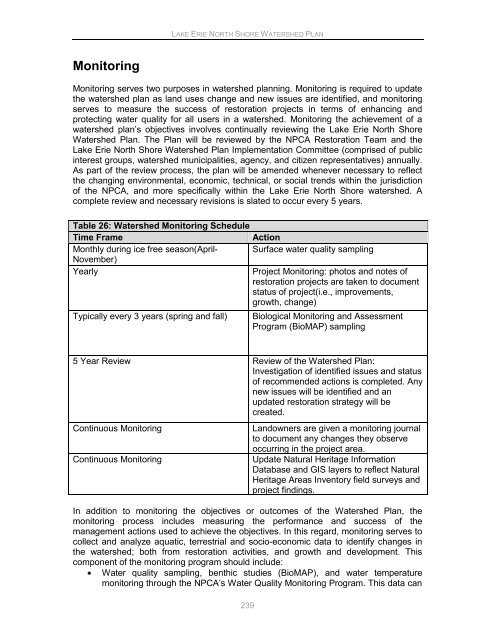Lake Erie North Shore Watershed Plan - Niagara Peninsula ...
Lake Erie North Shore Watershed Plan - Niagara Peninsula ...
Lake Erie North Shore Watershed Plan - Niagara Peninsula ...
You also want an ePaper? Increase the reach of your titles
YUMPU automatically turns print PDFs into web optimized ePapers that Google loves.
LAKE ERIE NORTH SHORE WATERSHED PLAN<br />
Monitoring<br />
Monitoring serves two purposes in watershed planning. Monitoring is required to update<br />
the watershed plan as land uses change and new issues are identified, and monitoring<br />
serves to measure the success of restoration projects in terms of enhancing and<br />
protecting water quality for all users in a watershed. Monitoring the achievement of a<br />
watershed plan‟s objectives involves continually reviewing the <strong>Lake</strong> <strong>Erie</strong> <strong>North</strong> <strong>Shore</strong><br />
<strong>Watershed</strong> <strong>Plan</strong>. The <strong>Plan</strong> will be reviewed by the NPCA Restoration Team and the<br />
<strong>Lake</strong> <strong>Erie</strong> <strong>North</strong> <strong>Shore</strong> <strong>Watershed</strong> <strong>Plan</strong> Implementation Committee (comprised of public<br />
interest groups, watershed municipalities, agency, and citizen representatives) annually.<br />
As part of the review process, the plan will be amended whenever necessary to reflect<br />
the changing environmental, economic, technical, or social trends within the jurisdiction<br />
of the NPCA, and more specifically within the <strong>Lake</strong> <strong>Erie</strong> <strong>North</strong> <strong>Shore</strong> watershed. A<br />
complete review and necessary revisions is slated to occur every 5 years.<br />
Table 26: <strong>Watershed</strong> Monitoring Schedule<br />
Time Frame<br />
Action<br />
Monthly during ice free season(April- Surface water quality sampling<br />
November)<br />
Yearly<br />
Project Monitoring: photos and notes of<br />
restoration projects are taken to document<br />
status of project(i.e., improvements,<br />
growth, change)<br />
Typically every 3 years (spring and fall)<br />
Biological Monitoring and Assessment<br />
Program (BioMAP) sampling<br />
5 Year Review Review of the <strong>Watershed</strong> <strong>Plan</strong>:<br />
Investigation of identified issues and status<br />
of recommended actions is completed. Any<br />
new issues will be identified and an<br />
updated restoration strategy will be<br />
created.<br />
Continuous Monitoring<br />
Continuous Monitoring<br />
In addition to monitoring the objectives or outcomes of the <strong>Watershed</strong> <strong>Plan</strong>, the<br />
monitoring process includes measuring the performance and success of the<br />
management actions used to achieve the objectives. In this regard, monitoring serves to<br />
collect and analyze aquatic, terrestrial and socio-economic data to identify changes in<br />
the watershed; both from restoration activities, and growth and development. This<br />
component of the monitoring program should include:<br />
Water quality sampling, benthic studies (BioMAP), and water temperature<br />
monitoring through the NPCA‟s Water Quality Monitoring Program. This data can<br />
239<br />
Landowners are given a monitoring journal<br />
to document any changes they observe<br />
occurring in the project area.<br />
Update Natural Heritage Information<br />
Database and GIS layers to reflect Natural<br />
Heritage Areas Inventory field surveys and<br />
project findings.
















